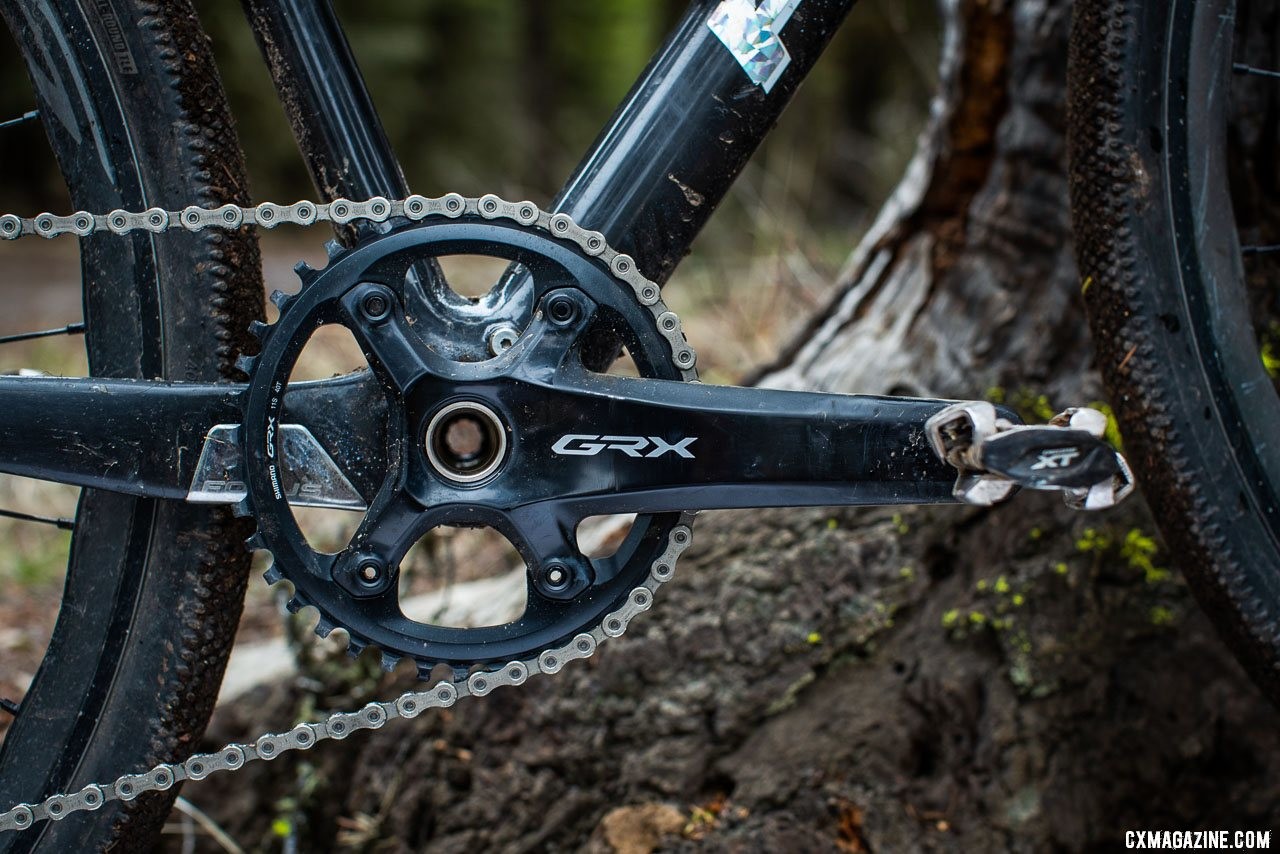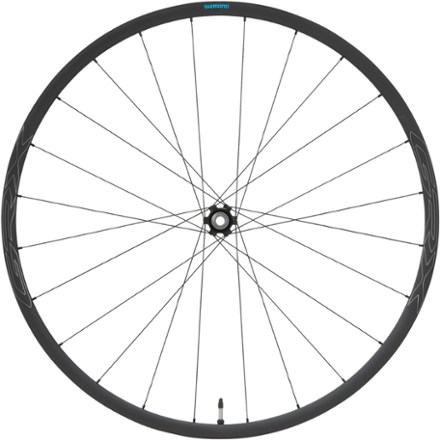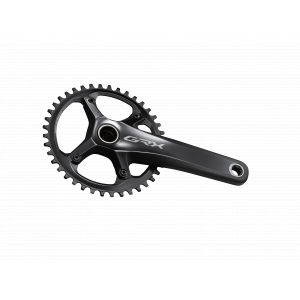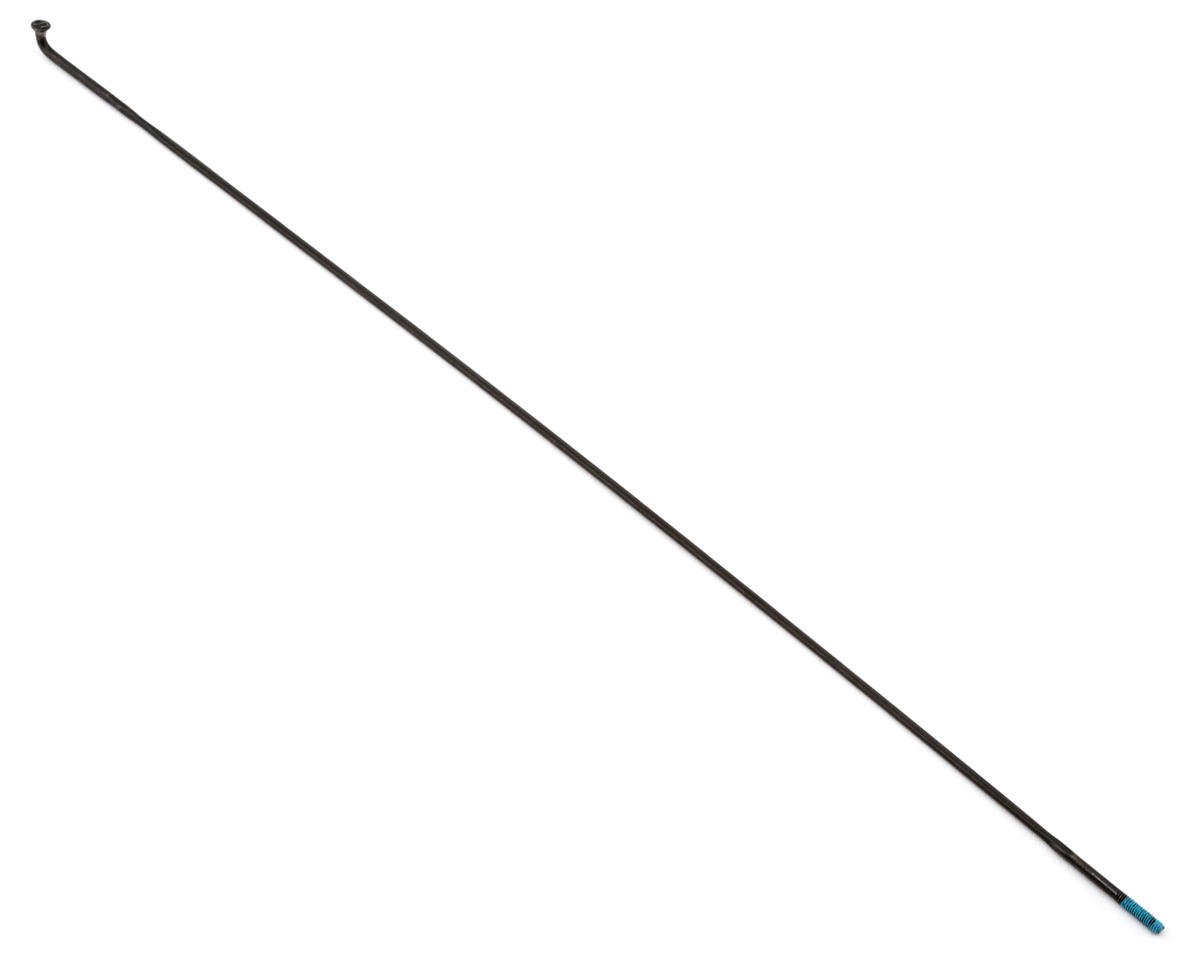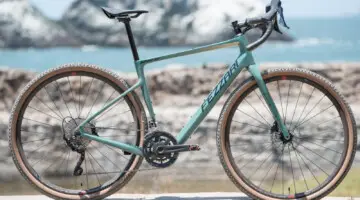During the summer, we first took possession of a mechanical GRX-equipped Trek Checkpoint, and then in late August, a GRX Di2-equipped Pivot Vault with Iso Flex, to test the new components.
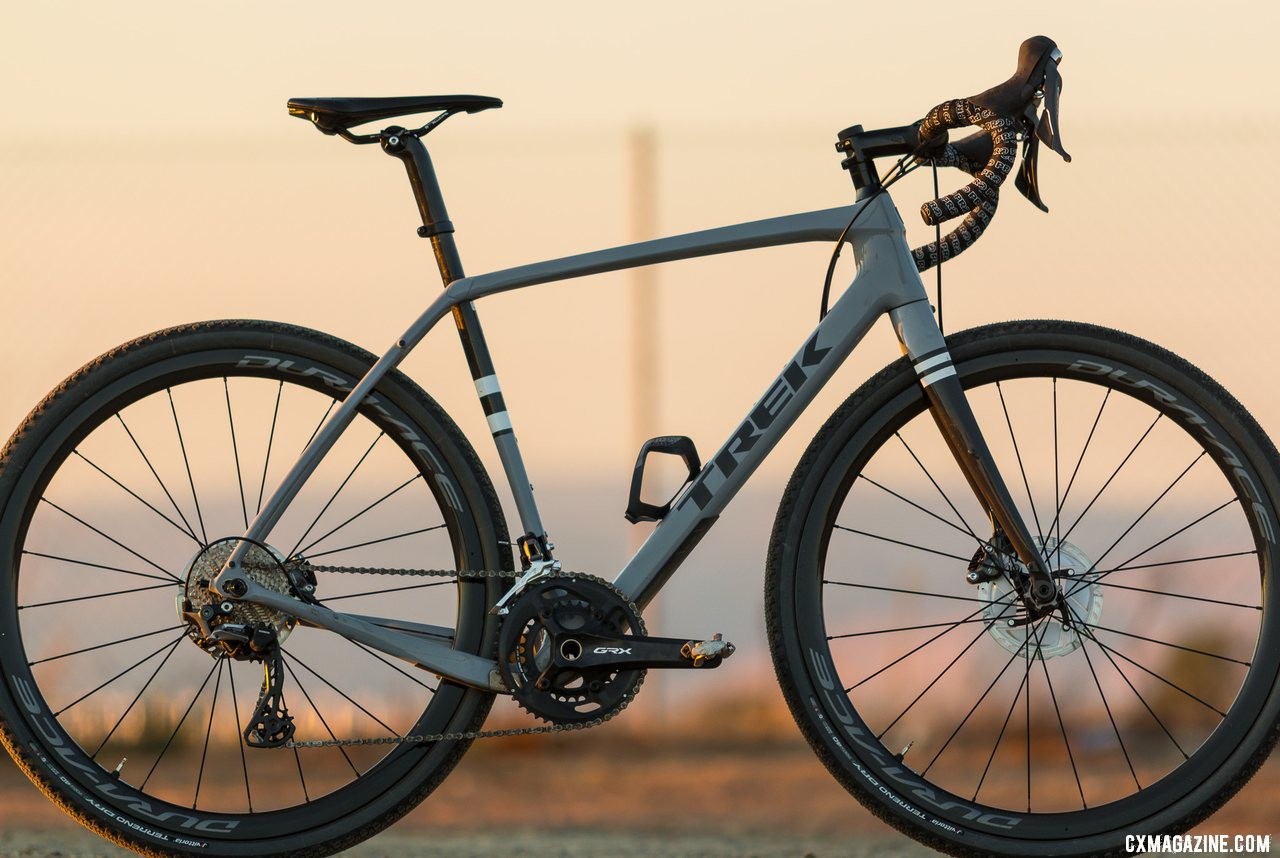
Shimano’s gravel-oriented GRX mechanical components, reviewed on a Trek Checkpoint gravel bike. © A. Yee / Cyclocross Magazine
Today, we offer up our in-depth review of the mechanical components from both a cyclocross and gravel perspective. Stay tuned for our in-depth review of the GRX Di2 group, and also our long-term review of SRAM AXS eTap.
GRX: It’s All in the Gearing
The biggest draw to Shimano’s new GRX mechanical shifting group is undoubtedly its gearing options. GRX has a plethora of choices and boasts one of the widest jumps between chainrings in a double crankset.
The 48/31 double chain ring combination offers an impressive range of gearing on any cassette, and paired with the 11-34 cassette, serves up a low and high gear that should be sufficient for almost any terrain you encounter.
The GRX-specific front derailleur handles shifting across the 17-tooth jump smoothly. Just as with the mechanical Dura-Ace equivalent we saw on the Specialized S-Works Crux, the front shifting is quick, precise, and if set up properly, offers rub-free performance. It’s a bit tricky to get the cable tension and limits completely dialed, but once they are, the front derailleur’s dual trim settings in both the small and big ring keep you rolling quietly.
Out on rolling, undulating terrain, the jump between the 48 and 31 chain rings is so big you’ll almost always have to compensate with a few rear shifts, but the double ring setup offers smaller jumps in the back while still offering a very low and very tall gear for steep climbs and descents, respectively.
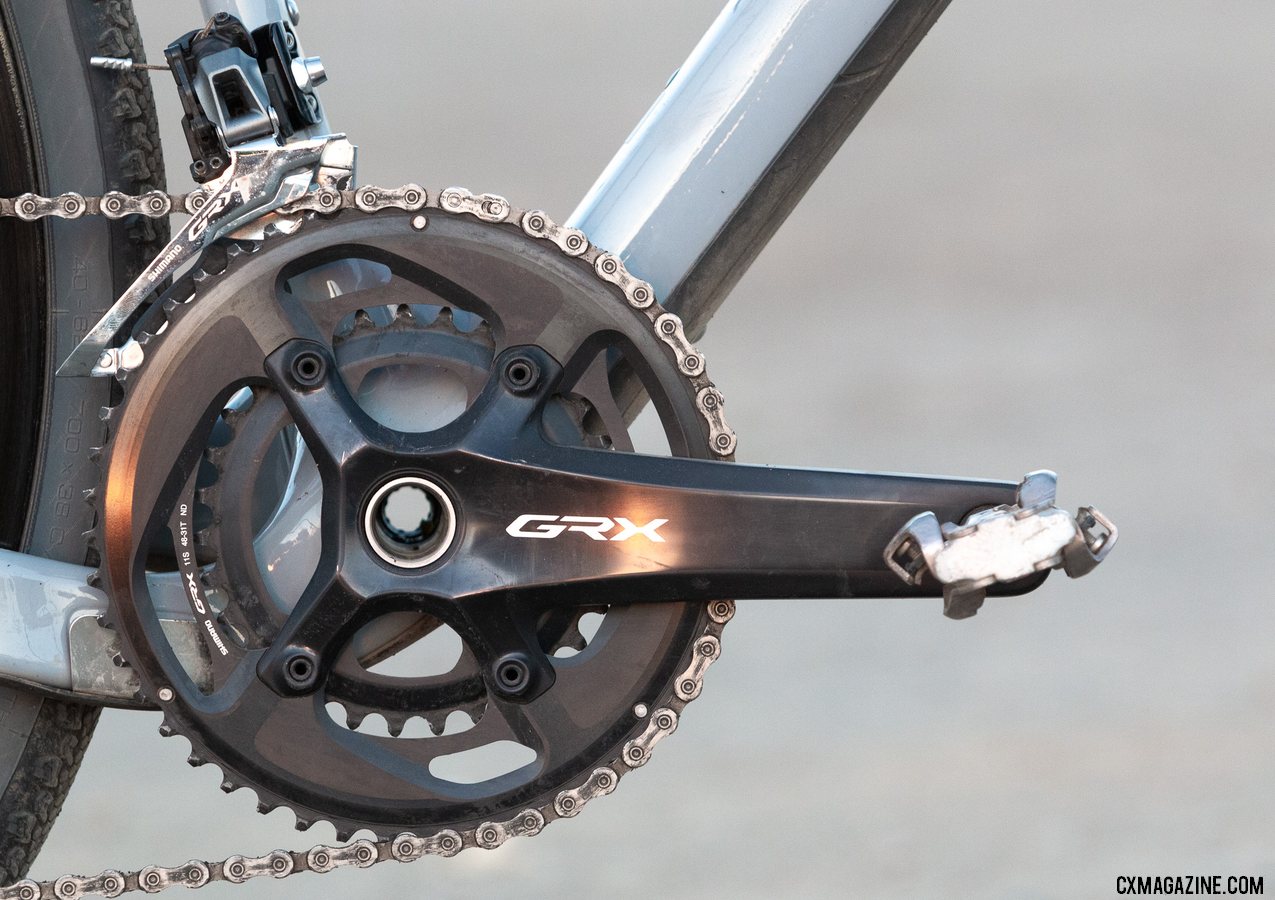
Shimano’s gravel-oriented GRX mechanical components offer wide range 2x gearing with a 48/31 chain ring combination. © A. Yee / Cyclocross Magazine
Think 1:1 is as low as you need? Everyone has different pedaling styles and strengths. I used to fall into that category and found a 42/42 gear low for any mixed terrain ride on 32mm cyclocross tires. But longer gravel rides, age and ballooning tire sizes all contribute to making what once felt like a cheater granny gear into an essential for any mixed terrain adventure in hilly California. Swapping a 32mm tire for a 45mm gravel tire can make your gearing as much as 4% harder. Of course, you could always opt for a corn cob rear cassette if you prefer 2x gearing and want to avoid the 31/34 low. Shimano’s GRX gearing offers options for many different types of riding and riders.
GRX: Shimano’s First Drop Bar 1x
Cyclocrossers rejoiced when Shimano also announced its 1x option with the GRX groups. Shimano brought 40t and 42t chain ring options to its top-shelf RX810-series crank, and a 40t chain ring to the RX600 series crank. Both 1x chainring options in the U.S. are for 11-speed chains. Europe, however, gets a 10-speed 1x crankset as well.
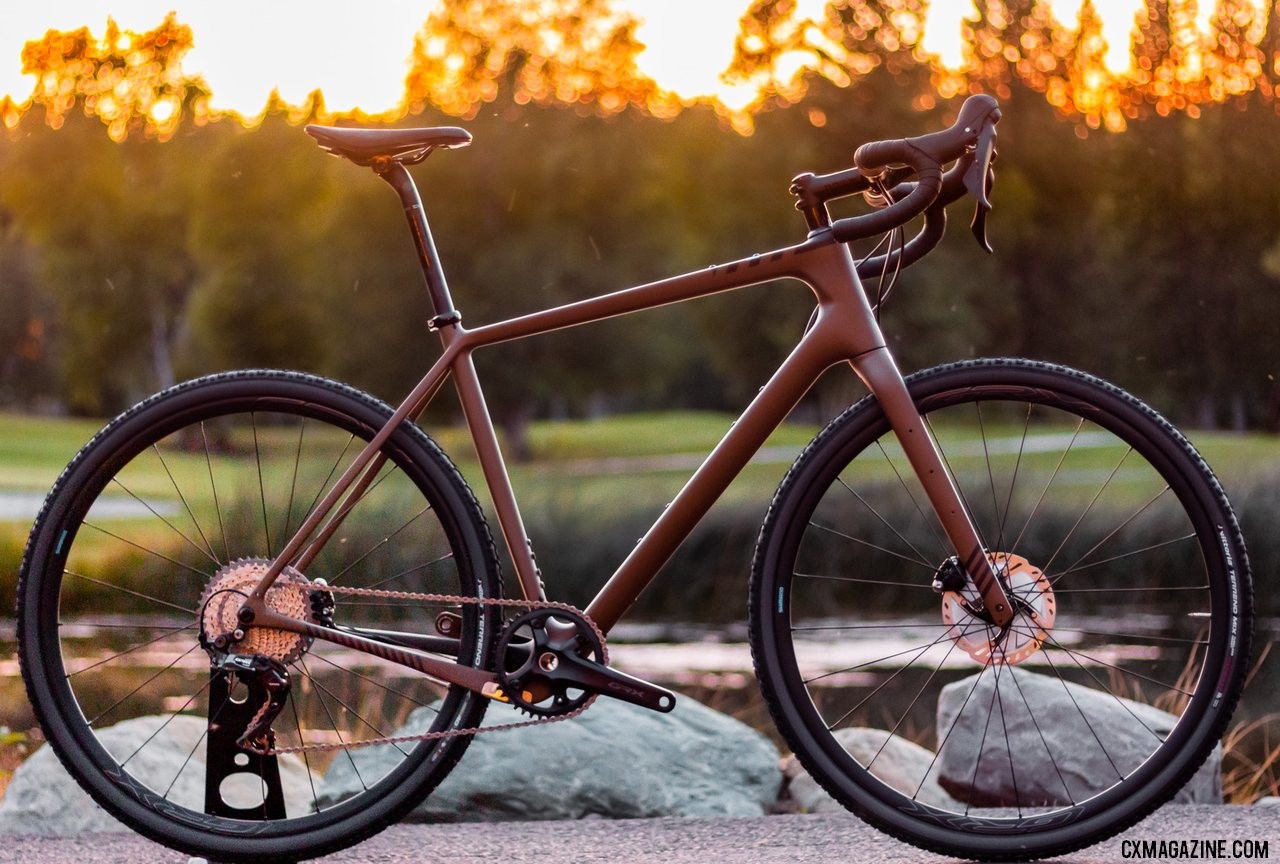
Shimano’s gravel-oriented GRX mechanical components come in both 1x and 2x drivetrain options. © A. Yee / Cyclocross Magazine
Although we have not yet reviewed the 1x chain ring itself (stay tuned), we have tested the 1x-specific rear derailleur with cassettes up to 11-42t. The clutch-based derailleur offers similar gearing range we’ve seen with the popular SRAM Force 1, Rival 1 and Apex 1 groups, with 11-34, 11-40 and 11-42 rear cassettes.
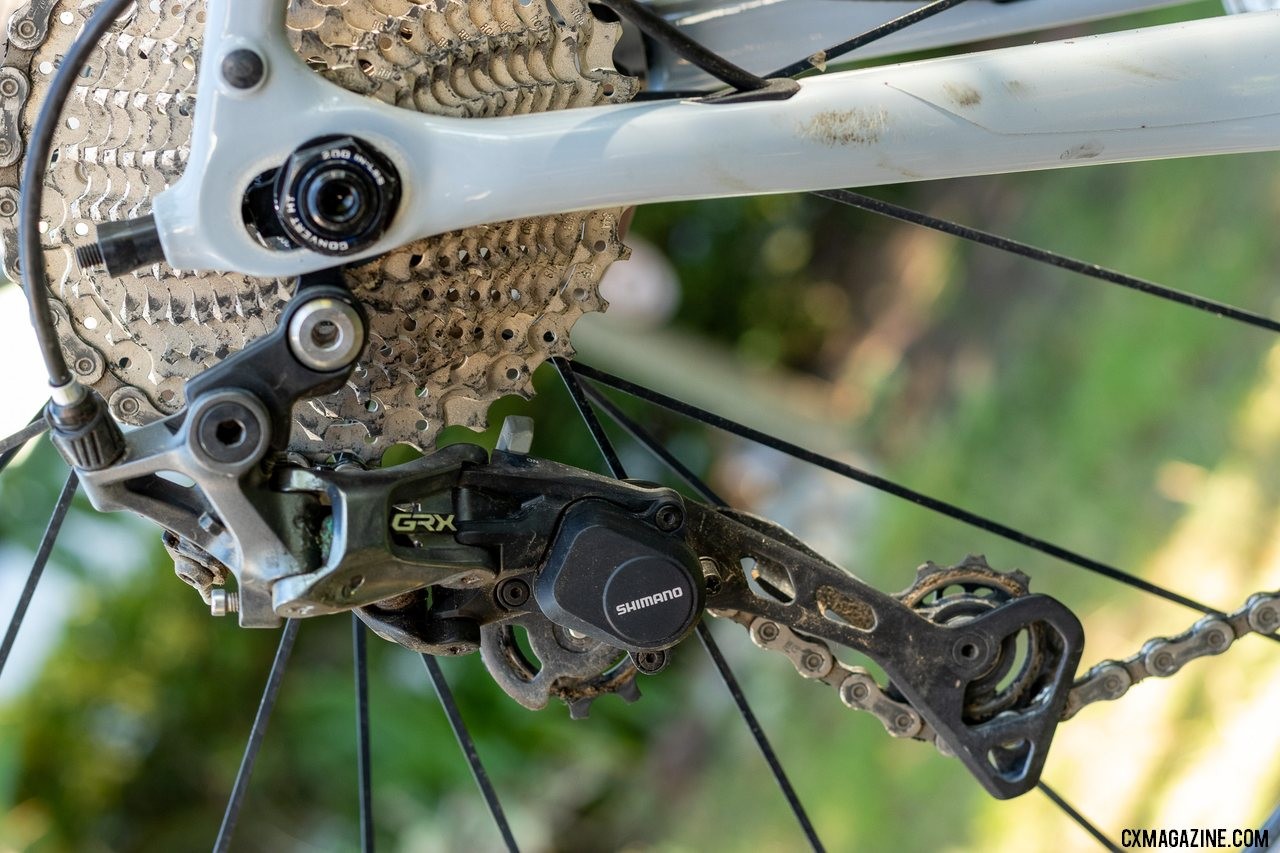
Shimano’s gravel-oriented GRX mechanical components include a 1x and 2x rear derailleur. The RX812 pictured is designed for 1x drivetrains and rear cassettes with up to a 42t large cog. © A. Yee / Cyclocross Magazine
Old school cyclocrossers may scoff at such low gearing options for cyclocross racing, but those of us without pro-level fitness or paid mechanics may value the low gearing for longer midweek rides or hilly race courses. Of course, such wide-range gearing is also well-suited for 1x gravel riders.
Up front, Shimano has some work to catch up to SRAM’s offerings, with just the 40 and 42t wide-narrow chain ring options, compared to SRAM’s 6 different 11-speed 1x chain ring offerings, starting at a 36t and ending with a 46t (SRAM’s 12-speed crank comes with a whopping 8 chain ring options from 36-50t).
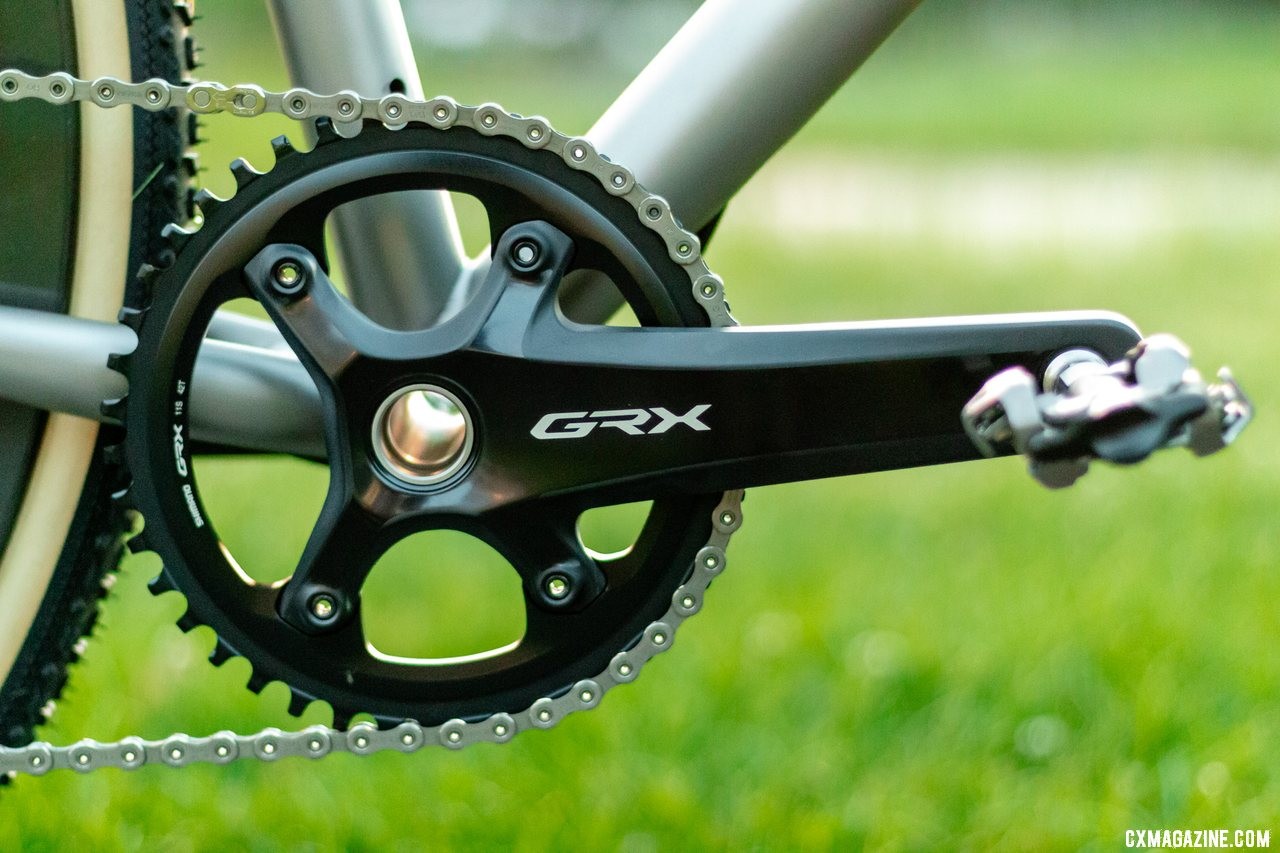
Shimano’s gravel-oriented GRX mechanical components include 1x and 2x crankset options. There are 40t and 42t chain ring options. © A. Yee / Cyclocross Magazine
We’d bet money that the company will eventually expand this offering. Need something smaller than a 40t? You can count on a third-party company meeting your need, but since it relies on the omnipresent 11-speed chain, you could also swap in a crankset from Easton, FSA, Praxis, SRAM or others to get your optimal gearing.
GRX: Clutch-based Chain Retention for 1x or 2x
While SRAM with its 11-speed Force 1, Rival 1 and Apex 1 drivetrains has dominated the 1x drop bar offroad drivetrain market, its popular roller bearing clutch derailleurs have been 1x only due to their limited capacity. With the exception of the new AXS 12-speed components, SRAM double chain ring drivetrains have been constrained to the non-clutch derailleurs.
Shimano’s GRX group offers clutch-based chain security, or as Shimano officially calls it, “integrated chain stabilizer mechanism,” both for 1x and 2x. Shimano already offered the switchable, adjustable chain stabilization on its Ultegra RX800 mechanical and RX805 Di2 rear derailleurs, but now has five different GRX rear derailleurs. There’s a 10-speed mechanical GRX rear derailleur oriented to 2x drivetrains (but will work with up to a 36t rear cog), mechanical and Di2 2x rear derailleurs (RX810/RX815), and mechanical and Di2 1x rear derailleurs (RX812/RX817).
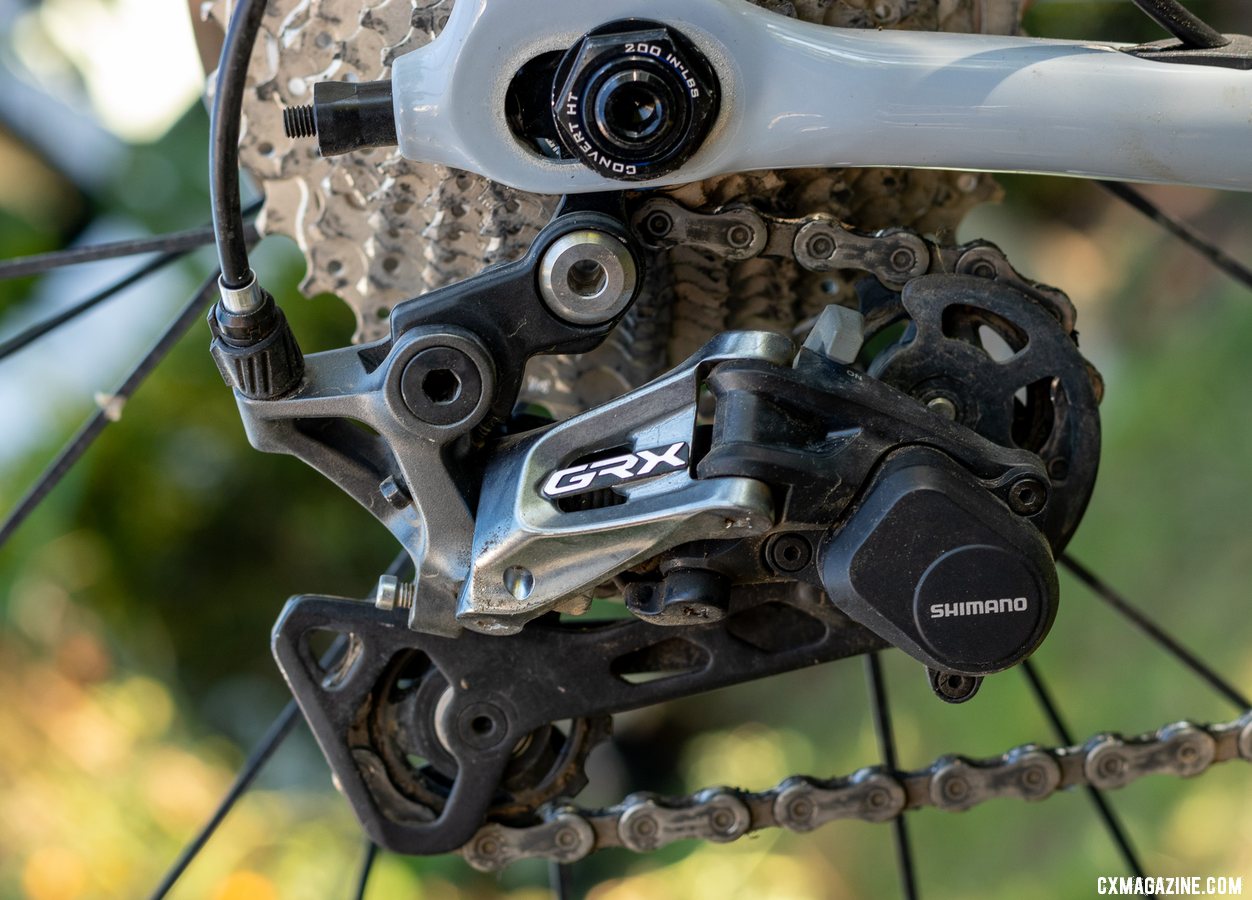
Shimano’s gravel-oriented GRX mechanical components include a 1x and 2x rear derailleur. Due to a mix-up, our test bike came with a 1x derailleur paired with the 2x crankset. It shifted well but was more challenged with chain wrap duties. © A. Yee / Cyclocross Magazine
Both the 2x-oriented RX810 and 1x-oriented RX812 rear derailleurs offer the crisp shifting you’d expect from Shimano, without chain slap. With the clutch engaged, shift action isn’t exactly light action, but it’s precise and most importantly, the chain stays on the chain rings. With the clutch off, it feels similar to Shimano’s non-clutch road offerings.
What makes a GRX derailleur 1x or 2x? The 1x derailleurs will work with rear cogs as big as a 42t, while the 2x derailleurs have more chain capacity through larger 13t pulleys and a different pivot position for the cage.
The downside is that if you want to swap between the most popular 1x and 2x drivetrain configurations, Shimano recommends swapping rear derailleurs. That project will set you back about $300 if you’re running Di2, or $110 if you’re running mechanical, for the derailleur alone. The good news is that if you’re already running GRX 2x, you can swap to 1x without a derailleur swap if you’re content with a maximum 34t big cog out back.
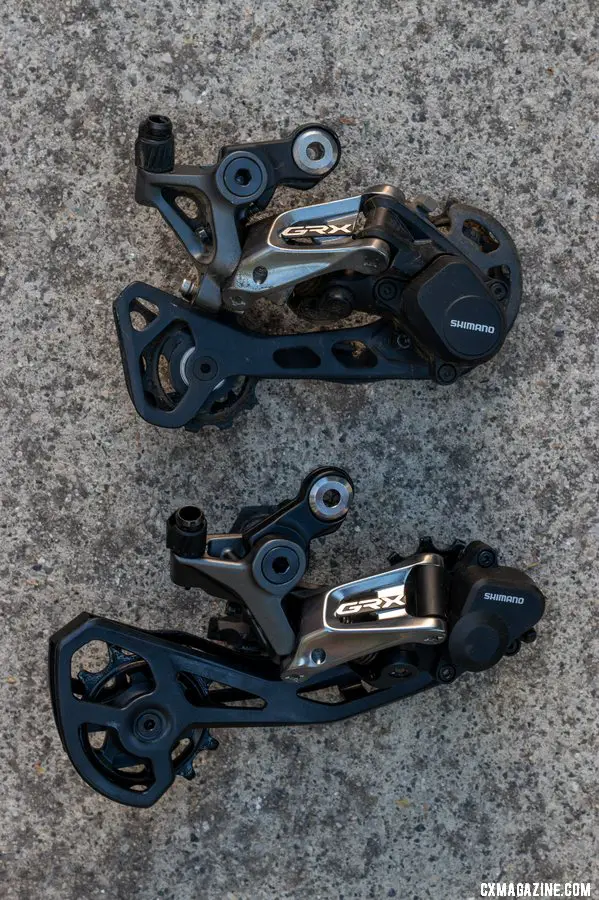
Shimano’s gravel-oriented GRX mechanical components include three mechanical derailleurs, including the two 11-speed options here. The 1x RX812 is on top, with the 2x RX810 below. © A. Yee / Cyclocross Magazine
Of course, there’s a difference between what’s recommended and what actually works. Due to a mix-up, our test bike arrived with a GRX 2x RX810 crankset, front derailleur and front and rear shifters, but with a 1x RX812 rear derailleur. It did the job without complaint or issue, and I likely wouldn’t have noticed until I asked Shimano’s Nick Legan why his bike had oversized pulleys while mine did not. Legan diligently followed up, and discovered by mistake I was supplied the wrong derailleur for the 48/31 and 11-34 drivetrain. In a day I had the proper unit.
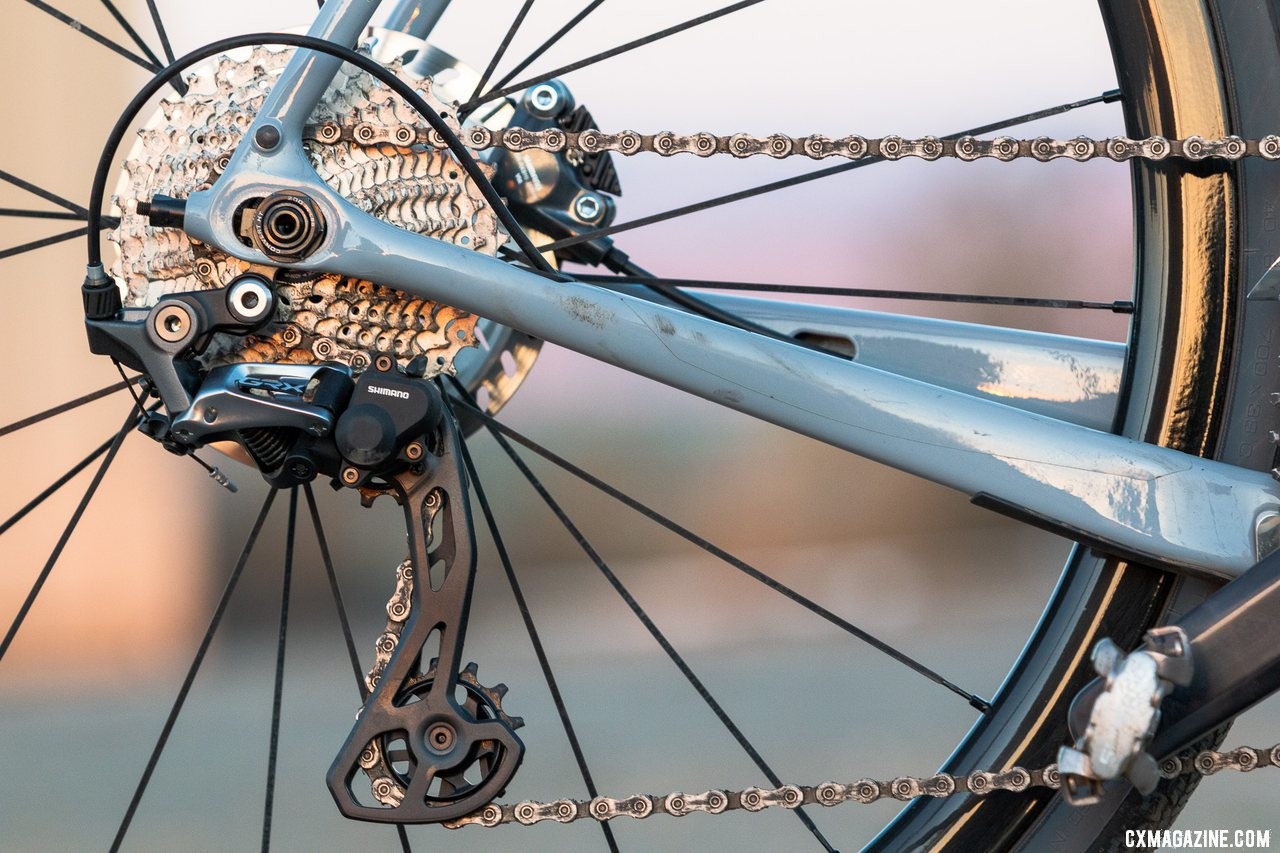
Shimano’s gravel-oriented GRX mechanical components feature a 2x-oriented RX810 rear derailleur with a clutch that comes with oversized pulleys for more chain wrap. © A. Yee / Cyclocross Magazine
I swapped the RX812 derailleur out for the RX810, made a few adjustments and hit the dirt again. The shifting was crisper across the two chain rings as the upper pulley of the RX800 derailleur remained consistently closer to each cog across the cassette. However, I’m thankful for the mixup, as it revealed the effectiveness of the Shimano clutch, as the 1x derailleur handled shifting duties without a chain drop, even though the drivetrain was 9 teeth over the derailleur’s stated capacity.
Similarly, the 2x derailleur can handle duty with larger-than-stated rear cogs with some aggressive B-screw adjustment. We’ve done the same with the RX800 and RX805 derailleurs. Shifting may not be optimal, but it’s certainly possible.
Shimano GRX boasts gearing versatility, but it’s actually even more than the specs indicate.
GRX Hits the Brakes
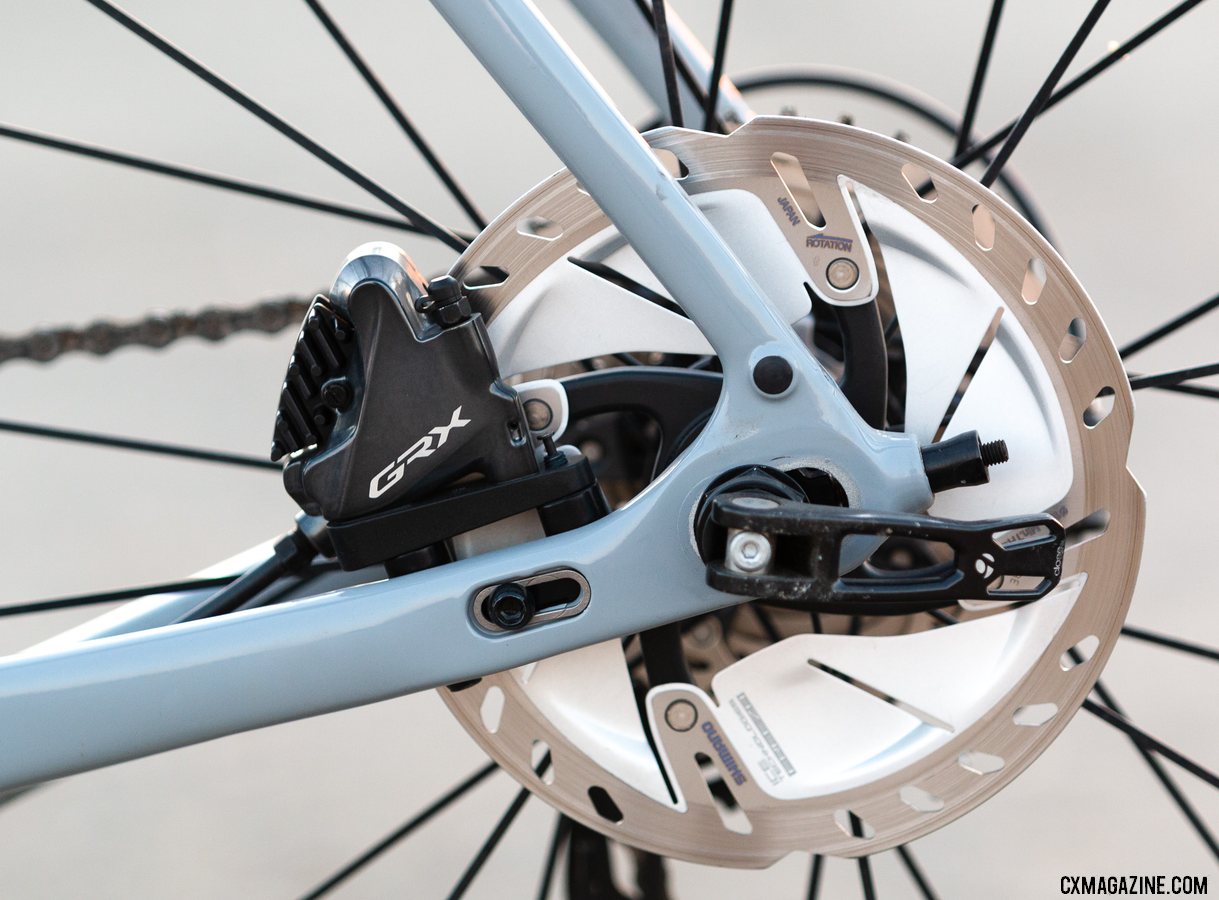
Shimano’s gravel-oriented GRX family of components include hydraulic flat mount disc brakes. © A. Yee / Cyclocross Magazine
While the GRX has its own calipers that look, feel and perform like the Ultegra equivalent, its mechanical shifting/ hydraulic brake levers offer a few differentiation points.
The first is relatively subtle but welcome—the STI brake levers now have a slightly rubberized texture—and offer more grip with or without gloves. It’s especially noticeable when it’s wet or when your hands are sweaty.
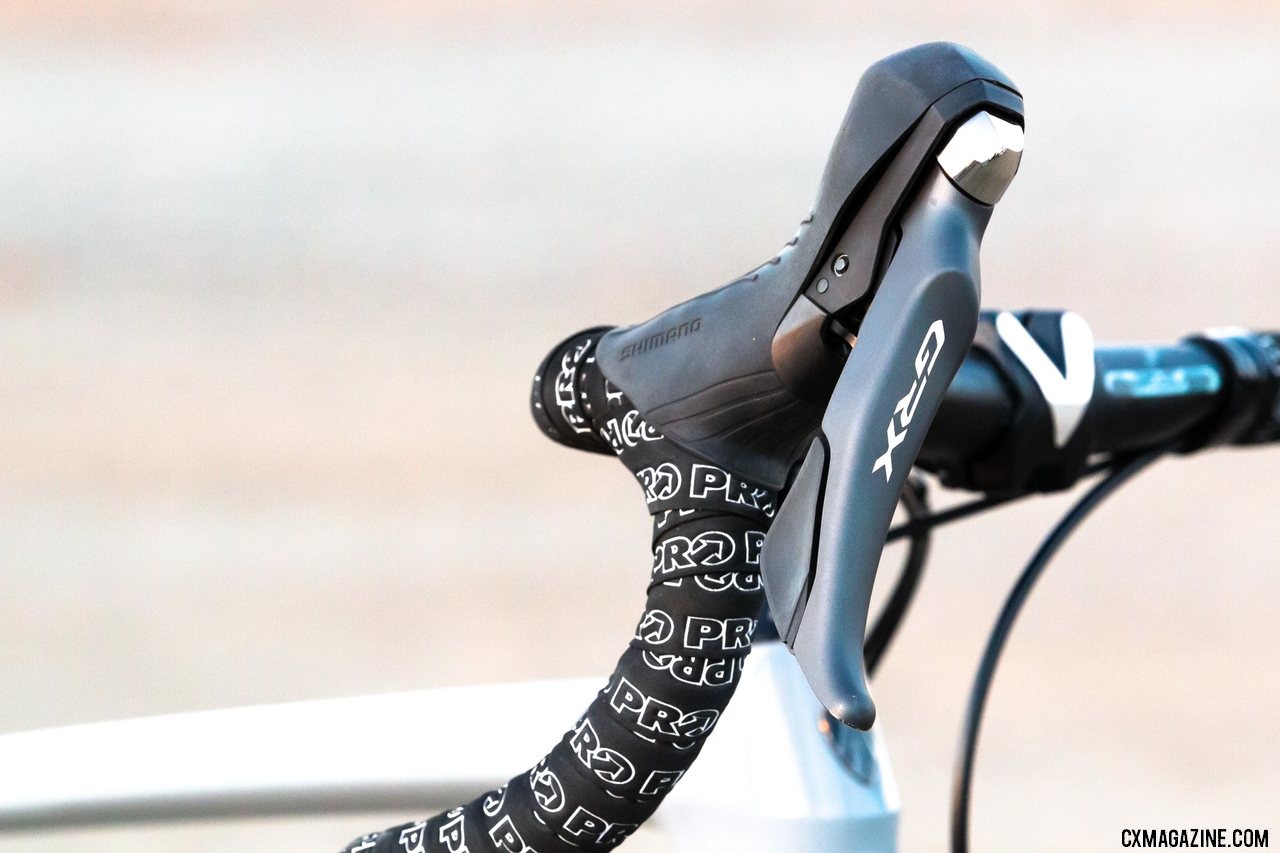
The new GRX mechanical STI levers feature a matte, grippy, slightly rubberized coating. Shimano’s gravel-oriented GRX mechanical components, reviewed. © A. Yee / Cyclocross Magazine
The mechanical shift lever hoods, while the same shape as the R8000 Ultegra hoods, have a new raised texture. The texture might look a bit aggressive, but it offers a comfortable and secure perch with or without gloves. When conditions get sloppy, the extra texture should offer more security.
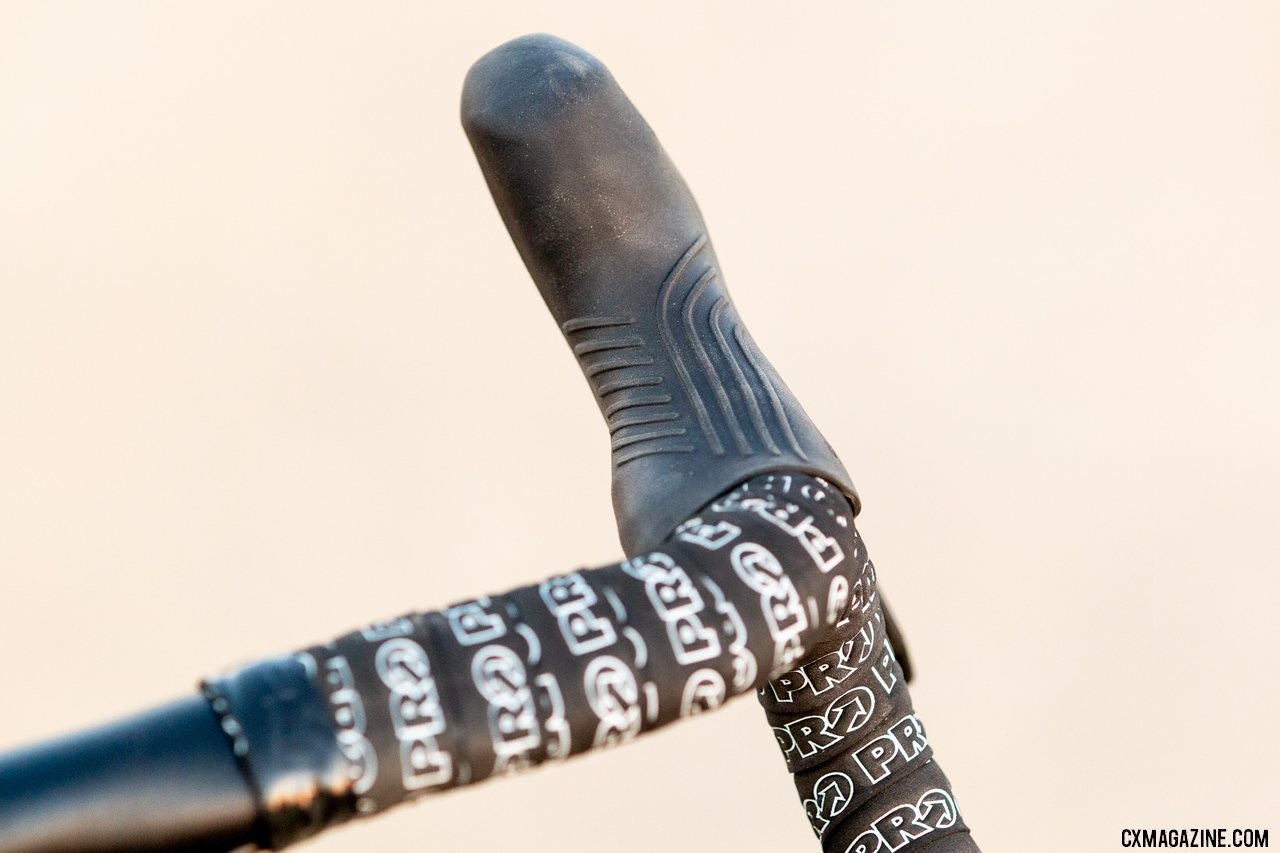
Shimano’s gravel-oriented GRX mechanical drivetrain features a new textured hood and a new grippy lever coating. © A. Yee / Cyclocross Magazine
Another brake offering that caught our attention when GRX was first announced was the inline brake levers, officially called “sub brake levers” by Shimano, or by old-timers, Runkel levers, after World Champ Dieter Runkel.
Inline levers on a drop bar’s tops were popular among cyclocrossers when rim brakes ruled the world.
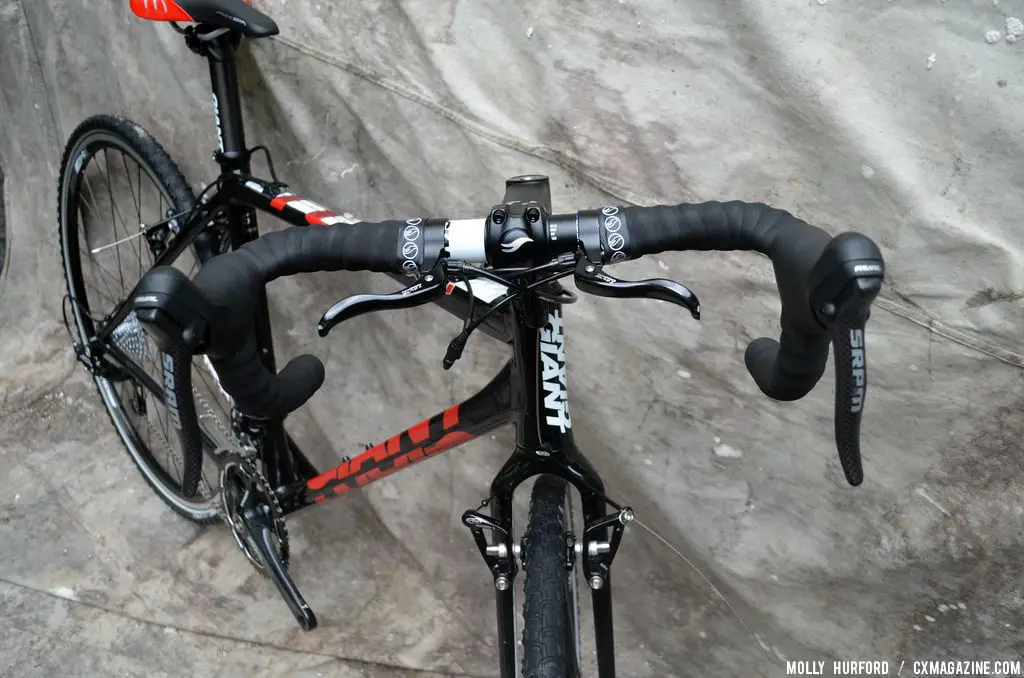
Inline brake levers were all the rage before hydraulic disc brakes. We’re happy Shimano brought them back with the RX812 sub brake levers. © Cyclocross Magazine
The gravel bike craze didn’t bring such a braking option because hydraulic disc brakes were already the default, but some of us still longed for them. Often while riding along in a group or paceline on bumpy, dusty gravel rides, we reminisced such easy-access braking.
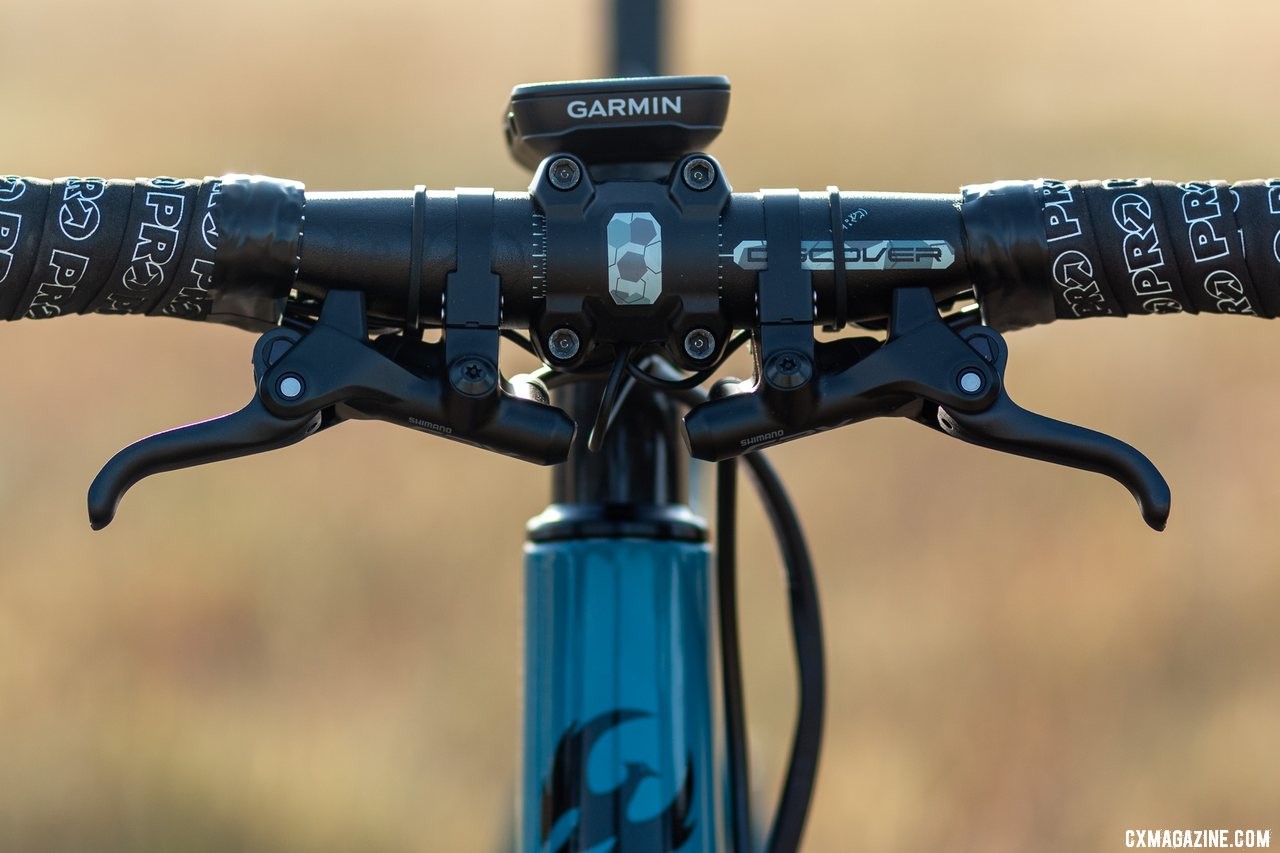
The GRX sub brake levers offer more hand positions on technical terrain and in group riding. Shimano’s gravel-oriented GRX mechanical components, reviewed. © A. Yee / Cyclocross Magazine
Inline brake levers are back thanks to Shimano’s RX812 sub brake levers, and they’re a fun addition to the handlebar. The levers a bit limited in that they are absurdly short, barely fitting two fingers, and their clamp requires them to be mounted near the stem clamp in a very narrow stance. Even so, they still greatly expand your usable hand positions in technical terrain. I’d love the ability to mount them wider on the bars for a position closer to a mountain bike flat bar, but still feel the braking convenience is worth the weight penalty.
If you’re running 1x, there’s also a left RX810-LA left brake lever designed to actuate a cable-pull dropper post. We did not test that component, yet, but look forward to pairing it with the new PRO Discover dropper post.
Overall, the RX810 GRX brake levers keep what we love about the R8020 Ultegra levers, including the Servo Wave technology (to move through initial pad travel quickly) and reach adjustment, and refined it for off-road riding.
GRX’s Limitations
The Shimano GRX family meets so much of what we’d expect in an off-road drop-bar component group. It offers great gearing and braking options, compatibility with a lot of existing Shimano and third-party components, and off-road-oriented features like chain security and grippy hoods and levers.
Its crankset is where you’ll find a few limitations. The crankset and chain rings are spaced 2.5mm further out than the Ultegra equivalent. This design should allow bike companies and frame builders in the future to maximize tire clearance without lengthening chainstays, and bigger chainrings on bikes where clearance by the chainstays is already tight. The downside, for some, is a wider Q-factor and a mandatory matching GRX front derailleur on 2x drivetrains.
Shimano counters the Q-factor complaint by pointing to its shorter spindle XTR SPD M9100 pedal option. These spindles are 2.5mm shorter per side, negating the wider stance of the GRX crank.
The requirement to pair the GRX crank with the GRX front derailleur is academic for most consumers buying a complete bike, but it can impact cyclocrossers and those looking to piece a bike together from existing parts.
Most serious 2x drivetrain cyclocross racers won’t want a 16-tooth or 17-tooth jump between the two chain rings, and prefer the 10-tooth jump as found in the Ultegra R8000 46/36 configuration.
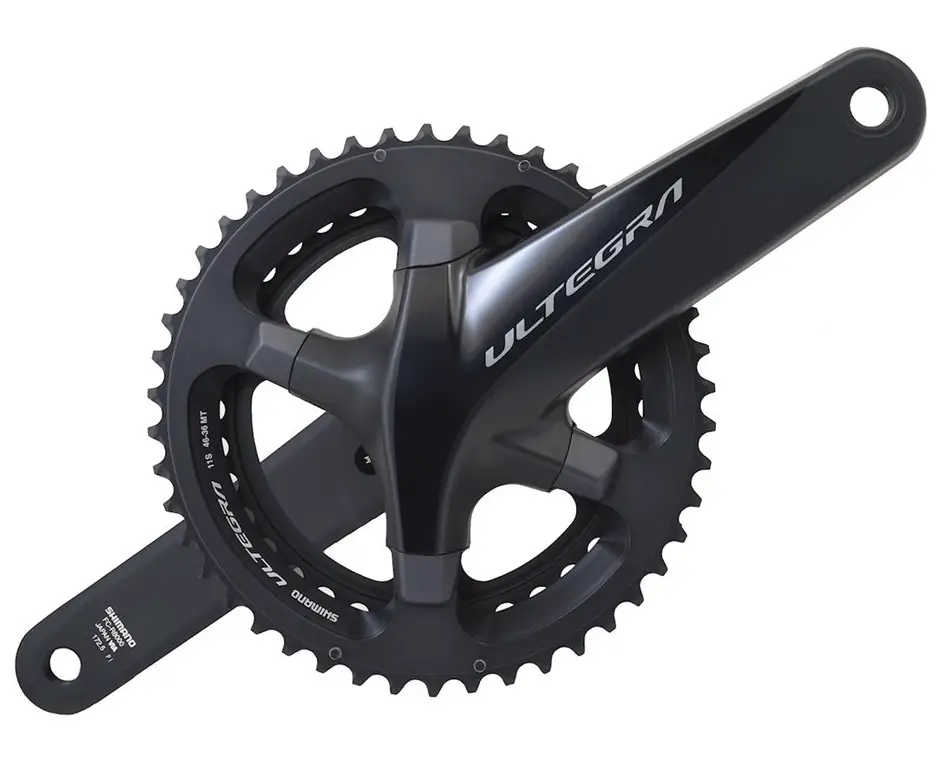
Shimano’s Ultegra R8000 crankset with 46/36 chain rings is still the best option for a cyclocross double, but it won’t work with the GRX front derailleur.
Unfortunately, those rings won’t fit on the GRX crankset, and Shimano doesn’t offer such a 46/36 option for its GRX bolt circle diameter. Thus, swapping between “gravel” and “cyclocross” chain ring combinations can get expensive, requiring different Shimano cranks and front derailleurs. While Shimano-sponsored cyclocross pros have embraced the GRX crankset in 1x format, 2x racers like Brannan Fix run a Dura-Ace crank with 46/39t rings, an Ultegra front derailleur and a GRX rear derailleur. Such combinations are essential for tighter, two-ring setups.
Of course, if you’re building up a bike from scratch, you’ve got lighter crankset alternatives like the Easton EC90 SL crankset that offer both 46/36 cyclocross and 16-tooth spread 46/30 “gravel” chain rings and work with a single non-GRX front derailleur.
The GRX crankset uses a proprietary 80mm four-arm BCD for its small 31 or 30 tooth inner ring, but a 110mm BCD outer ring. On paper, the 110mm four-arm BCD looks exactly the same as what its four-arm road cranksets use and third-parties have copied, but Shimano assured us that mix-and-match fans hoping to put a 46 or 50 tooth Ultegra ring on a GRX crank will be disappointed. They’re not compatible and won’t work without a file or Dremel. That’s a big bummer.
Shimano undoubtedly wants to control shifting quality by avoiding such unintended combinations, but the tweak of an existing standard certainly constrains cross-compatibility.
Owners of an existing Shimano Dura-Ace, Ultegra or 105 four-arm crank will also still have to rely on third-party companies to convert to a single ring drivetrain. It’d be fabulous for them to be able to buy a 1x GRX ring to go 1x for cyclocross or gravel, but Shimano says the GRX 1x rings won’t quite fit despite the same BCD and number of bolt holes. (Stay tuned as we explore what’s involved to do just that.)
GRX Wheels: A Killer Value
Lost in all the discussion about clutch derailleurs, gearing and cross-compatibility is the fact that Shimano has a sweet set of GRX wheels that deliver outstanding value.
In typical Shimano style, they aren’t revolutionary in terms of specs. They’re just 21.6mm wide, quite conservative and a far cry from the 30mm width of Roval’s latest ultralight gravel-oriented Terra CLX EVO wheels. They’re also just $419 and weigh around 1650g in a 700c size. Would you add 300g to save $2k?
The wheels follow Shimano’s long history of using easily adjustable and serviceable cup-and-cone bearings and avoiding easily-gouged alloy freehubs. The freehub material, in an area with minimal rotational weight implications, is durable steel. The brake rotor mount relies on Shimano’s Centerlock spline of course.
There’s also a 650b option that is 50g lighter.
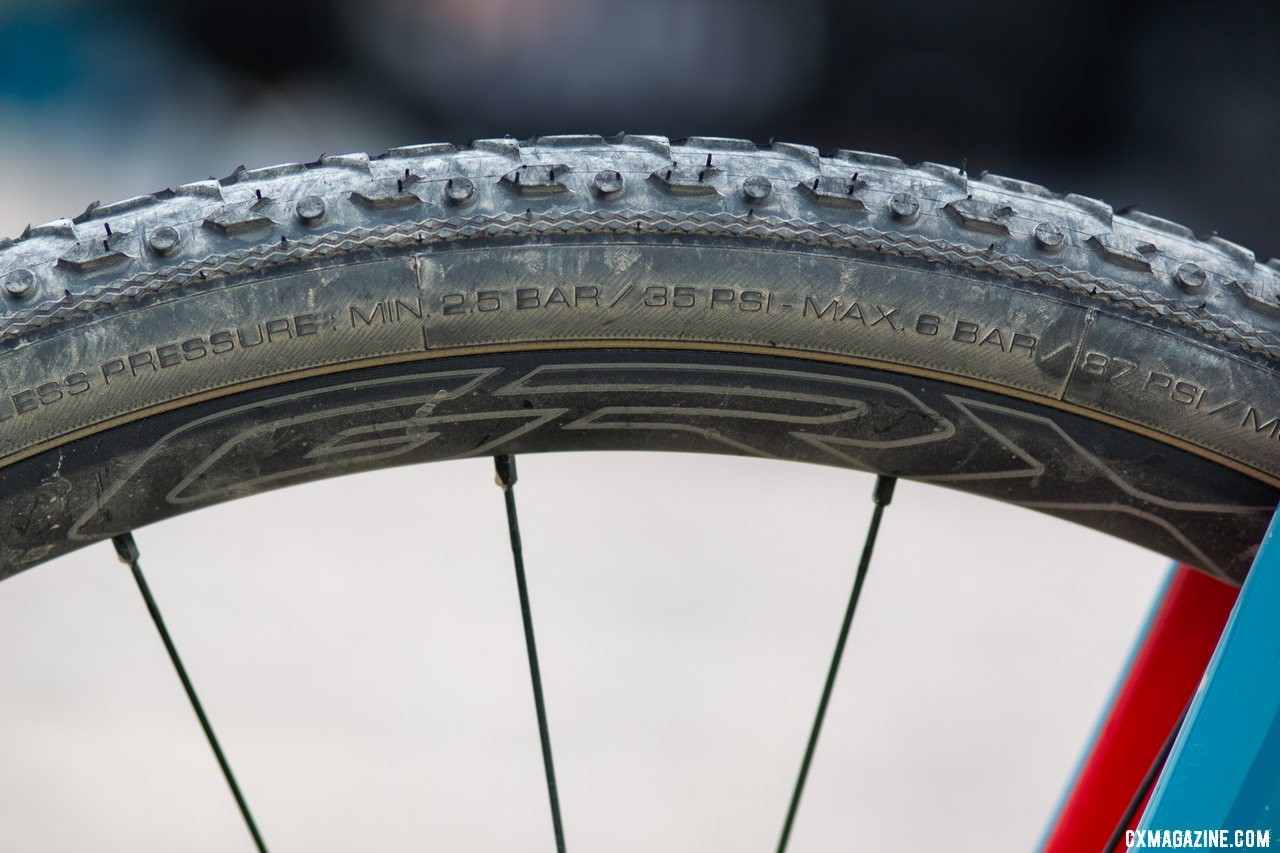
Shimano’s gravel-oriented GRX includes a lightweight GRX wheelset that packs a lot of value into its $419 price tag. © A. Yee / Cyclocross Magazine
During rides, GRX wheels gripped Vittoria Terreno Mix 40mm tires tightly without a burp at low-pressure riding. They’ve also been impressively airtight overnight and over time.
After several weeks of testing, the GRX RX570 wheels are still rolling true despite rough adventures in two states, several trips inside a bike box and a few spills.
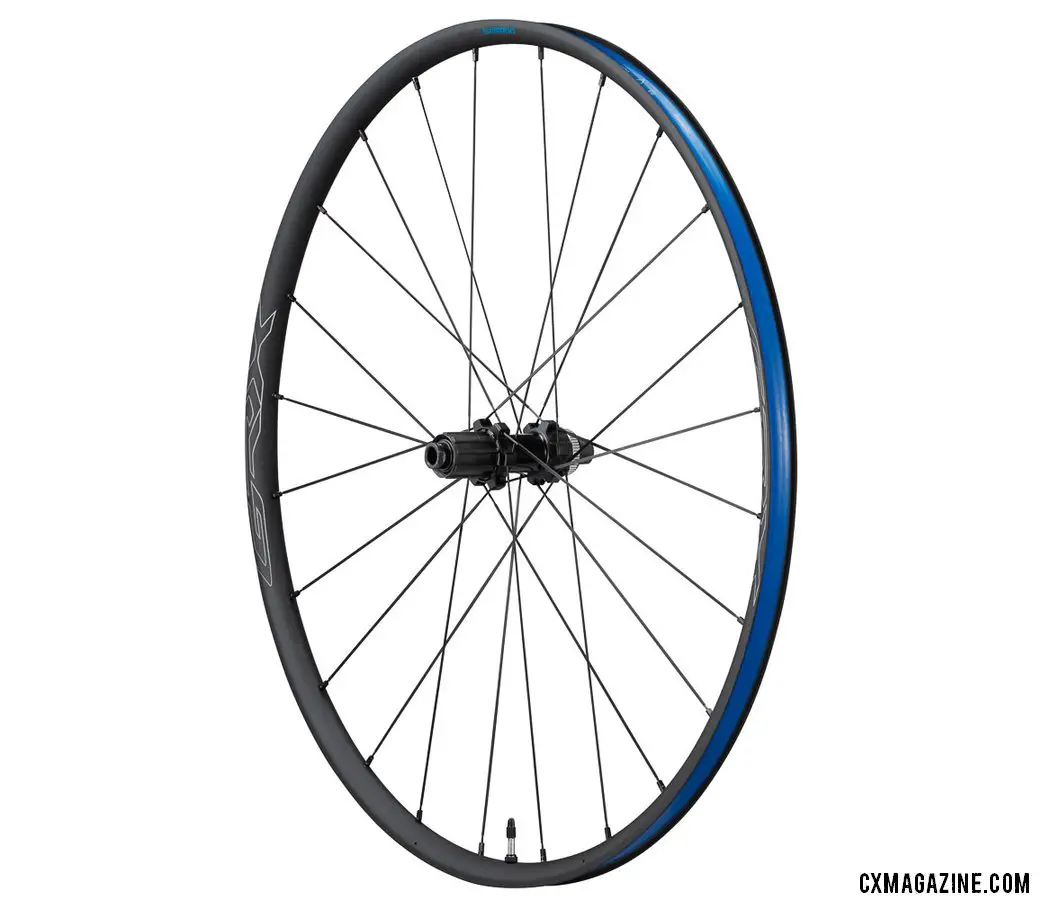
Shimano’s new GRX gravel/cyclocross family of components has one wheelset, the 21.6mm wide RX570 wheelset. It comes in both 700c and 650b diameters.
Anyone looking for a budget-friendly performance upgrade over stock wheels should give the GRX wheels a close look.
The Verdict
Shimano pulled out all the stops with its gravel-oriented GRX family of components.
The mechanical options I reviewed deliver expanded the gearing options and outstanding shift performance for not just cyclocross and gravel, but all types of drop bar riding. The wide-range 2x gearing will be welcomed by many road cyclists, while the 1x option could make an excellent commuter bike drivetrain.
Yeah, I’m greedy and impatient. I want more 1x chainring options, more cassette options, wider rims and more mounting positions for the inline levers, but I’m sure most of those are already on the drawing board. It’s also true that Shimano’s GRX group is a welcomed, if not overdue, step into the world of 1x drivetrains.
Yet with its wide-range 2x gearing, 1x options, inline brake levers, grippy levers, value-packed wheelset and even 10-speed compatibility, Shimano’s GRX family of mechanical components really has something for everyone.
Sure, it’s not 12-speed or bleeding edge, but for the way many of us ride, it doesn’t need to be. Shimano GRX is the most versatile group of drop-bar components, hands-down.
Stay tuned for our in-depth review of the Di2 GRX components, long-term review of SRAM AXS eTap Red, and initial review of SRAM AXS eTap Force and Eagle.
More info: shimano.com or shop now and support our coverage.
Shimano GRX Mechanical Drivetrain, Brakes and Wheelset Photo Gallery and Pricing:













